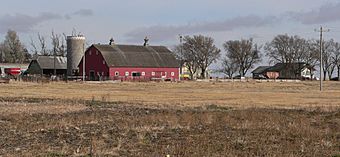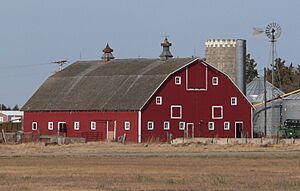Nelson Farm, Nebraska facts for kids
Quick facts for kids |
|
|
Nelson Farm
|
|

Viewed from the southwest.
|
|
| Location | 1139 M Rd in Merrick County, Nebraska, west of Central City |
|---|---|
| Built | 1887 to 1950s |
| Architect | John M. Nelson and Herman Nelson |
| NRHP reference No. | 09000650 |
| Added to NRHP | August 26, 2009 |
The Nelson Farm is a historic farm in Merrick County, Nebraska, a state in the central United States. It was started by Swedish immigrants in 1879 and stayed in the same family for many generations. Over 80 years, the farm grew and changed, showing how farming and buildings developed over time.
This farm is so special that it's listed on the National Register of Historic Places. It helps us understand what farm life was like in Merrick County from the late 1880s to the 1950s. It also shows how building styles and farming methods changed as new technology became available.
Contents
A Look Back: The Farm's History
In 1858, the Nebraska government created Merrick County. Many early settlers came from countries like Ireland, Germany, and Sweden. In the early 1870s, more people moved to Merrick County. However, a huge swarm of grasshoppers destroyed crops in 1874, making life very tough.
Starting the Farm (1879-1921)
In 1879, a Swedish immigrant named John Magnus Nelson moved to Merrick County. He had come to the United States at age 22 and lived in Illinois for six years. John and his wife, Ina Peterson, claimed 160 acres of land west of Central City. They did this under the Homestead Act, which allowed settlers to get land if they lived on it and farmed it.
John first built a sod house, which is a house made from chunks of grass and soil. He and his family lived there for seven years. In 1887, John built a two-story wooden house. Later, in 1916, he added a large barn. John likely got ideas for his farm from Swedish magazines, farming guidebooks like The Farmer's Almanac, and advice from his neighbors.
As John's son, Herman Nelson, started helping more with the farm, they began using "scientific farming" ideas. These were based on newer guidebooks and helped them organize the farm better. By 1921, the Nelson Farm had grown to 480 acres!
Tough Times and New Ideas (1930s-1950s)
The Great Depression was a very hard time for the Nelson Farm. Growing the farm so much might have made things even tougher. During this period, they didn't add many new improvements to the farm.
By 1935, Herman Nelson realized they needed a way to water their crops. Since there wasn't a system to bring water from the Platte River, he installed a deep-well irrigation system. This made the Nelson Farm one of the first in Merrick County to use this method to get water for crops.
In 1935, Herman Nelson also built a new house for his son, who was getting married that year. More improvements followed. A tall cement silo was added in the 1940s to store corn and other grains. The old building used for storing grain was changed into a machine shed. In the 1940s and 1950s, an Aerometer windmill was put up to pump water for the animals, and a metal shed was built for storage.
Not many changes happened on the farm from 1959 until 2002. At that time, they switched from deep-well irrigation to center-pivot irrigation, which uses large sprinklers that rotate in a circle.
As of 2009, the Nelson Farm was still being run by members of John M. Nelson's family, now the fourth and fifth generations!
What They Farmed
Throughout its history, the Nelson Farm mainly grew crops to feed its animals. Any extra crops were sold. In the early years, corn was likely the main crop. Later, alfalfa was added. Alfalfa is good for animal feed and also helps add important nutrients to the soil.
The farm also raised animals. Horses were very important for pulling farm equipment until machines took over. Cattle and hogs were raised to be sold for meat for most of the farm's history. In the early 1900s, the farm had a dairy herd of 40 to 50 Holsteins for milk. The women on the farm also raised chickens for meat and eggs.
Exploring the Farm: What You See Today
The Nelson Farm today includes the northern 80 acres of John M. Nelson’s original land. The main farm buildings are in the southern 40 acres. An unpaved road leads to the houses. The farm buildings area is about six acres.
It has a line of trees on the north side that helps block the wind. There used to be trees on the west side too, but most have been removed. Agricultural fields border the south and east sides. The houses are on the eastern part of the farm. The other two-thirds of the farm have buildings for animals, machines, and storing crops. This area includes the large barn, the machine shed, a metal shed, concrete and metal silos, and a windmill. The rest of the Nelson Farm is made up of fields used for growing crops.
Important Buildings
- House (1887): John M. Nelson built this two-story wooden house. It's a type of "ell house," which was common on farms in the Midwest during that time. It sits on a foundation of limestone blocks and has simple decorations.
- Barn (1916): Built by Herman Nelson, this large wooden barn is the most noticeable building on the farm. It's 84 feet long, 64 feet wide, and 40 feet tall, making it one of the tallest buildings in Merrick County! In 2007, it took 135 gallons of red paint to repaint it. The barn has a big hay loft above the main floor, where animals were kept. Its huge gambrel roof (a roof with two different slopes on each side) is very impressive. Not many changes have been made to the barn over the years.
- House (1935): Herman Nelson built this house. It's a one-story house that looks like a simpler version of the "bungalow style." It has a sloped roof with an overhanging edge supported by exposed beams, which is a key feature of bungalows. The back of the house has a two-car garage.
- Concrete Silo (1940s): This silo is almost as tall as the barn. It was used to store corn and other grains. It was built by stacking pre-made concrete pieces that fit together, giving it a ringed look.
- Machine Shed (1940s): This building was originally used to store grain but was later changed into a machine shed. The original grain storage building was probably built around the same time as the barn. To make it a machine shed, they removed the elevator and one wall. These changes show how farming moved from using horses to using machines.
- Metal Shed (1950s): This is a pre-made metal building with wavy sides. It's a style of utility building that became popular during World War II. It was added to store more farm equipment.
- Windmill (1950s): This is a 702 Aermotor Windmill model. It was used to pump water for the farm animals. It's about 40 feet tall, with a steel wheel about 8 feet across. It's not used anymore, but it's still in good condition.
Important Outdoor Areas
- Windbreak (1880s): John M. Nelson planted this line of trees after he chose the spot for his farm. It stretches about 900 feet from the western edge of the farm. It's made up of mature trees that lose their leaves in winter and evergreen trees.
- Agricultural Fields (1880s–1920s): These fields surround the farm buildings on the north, south, and east sides. They are used for cattle to graze and for growing crops like corn and soybeans.
Why the Farm is Important
In 2009, the Nelson Farm was added to the National Register of Historic Places. It was recognized as important for several reasons:
- It shows how farms in rural Merrick County were first started and then grew from the time of homesteading through the 1950s.
- It's an example of how new and improved farming methods were used in Merrick County during this time.
- It illustrates how building styles and their uses changed as technology developed. For example, the windbreak was planted to protect animals, showing how much they relied on horses for farming in the early days. The 1916 barn was first built to shelter horses, but its purpose changed later when machines took over.
The Nelson Farm was also one of the biggest farms in Merrick County's Lone Tree Township for a while. In 1921, the Nelson family farmed more acres than any other family in that area!




